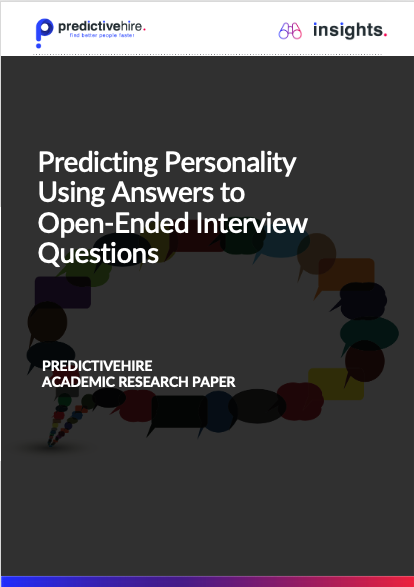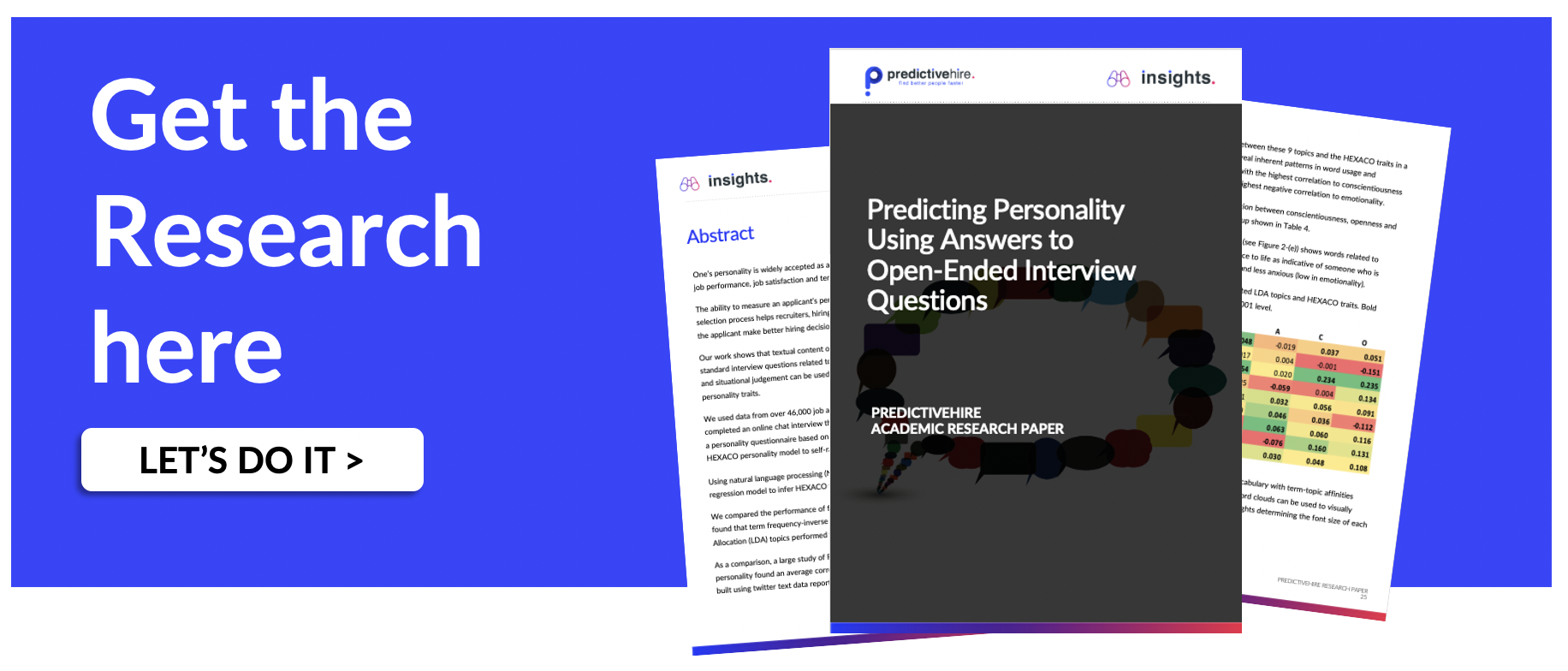Re-inventing personality assessments through text-based interviews.
 PredictiveHire has recently released a scientific research paper that shows that a simple chat interview can measure personality with improved user experience and at a fraction of the time required for a traditional psychometric assessment.
PredictiveHire has recently released a scientific research paper that shows that a simple chat interview can measure personality with improved user experience and at a fraction of the time required for a traditional psychometric assessment.
It proves that textual content of answers to standard interview questions related to past behaviour and situational judgement can be used to reliably infer personality traits. It explores how the AI techniques of Natural Language Processing (NLP) and Machine Learning (ML) present a new future for personality assessments.
Why this matters?
The ability to measure an applicant’s personality in the selection process helps recruiters, hiring managers and the applicant make better hiring decisions, including removing the subjective biases involved in human interviewer judgement of candidate personality.
Personality is widely accepted as an indicator of job performance, job satisfaction and tenure intention.
The research outcomes suggest that the work is more enjoyable and thus engaging to the individual and beneficial to the employer and the society at large when there is congruence between one’s personality and career.
However, conducting a traditional personality test adds an extra cost to the recruitment process. It also tends to diminish candidate experience as personality tests are less favoured by candidates compared to other assessment methods such as job interviews.
Interviews have been the preferred method of assessment
Therefore personality tests are not as ubiquitous as employment interviews. Actually, for the past 100 years, interviews are the most widely used selection method in. However, strong criticism of the job interview is the likelihood of bias introduced by the prejudices of the interviewer.
Structured interviews where the same questions are asked from every candidate, in a controlled conversation flow and evaluated using a well-defined rubric have shown to reduce bias and also increase the ability to predict future job performance. The questions asked in a structured interview are derived using a job analysis as opposed to interviewer preference and are typically based on past behaviour and situational judgement.
This research paper is written by Madhura Jayaratne, Data Scientist and Buddhi Jayatilleke, Principle Data Scientist of PredictiveHire.
The ability to infer personality from interview responses could replace lengthy and less favoured personality tests while also providing objective outcomes from text interviews.
Related
Blog
Neuroinclusion by design. Not by exception.
Why neuroinclusion can’t be a retrofit and how Sapia.ai is building a better experience for every candidate.
In the past, if you were neurodivergent and applying for a job, you were often asked to disclose your diagnosis to get a basic accommodation – extra time on a test, maybe the option to skip a task. That disclosure often came with risk: of judgment, of stigma, or just being seen as different.
This wasn’t inclusion. It was bureaucracy. And it made neurodiverse candidates carry the burden of fitting in.
We’ve come a long way, but we’re not there yet.
Shifting from retrofits to inclusive-by-design
Over the last two decades, hiring practices have slowly moved away from reactive accommodations toward proactive, human-centric design. Leading employers began experimenting with:
- Sharing interview questions in advance
- Replacing group exercises with structured simulations
- Offering a variety of assessment formats
- Co-designing assessments with neurodiverse candidates
But even these advances have often been limited in scope, applied to special hiring programs or specific roles. Neurodiverse talent still encounters systems built for neurotypical profiles, with limited flexibility and a heavy dose of social performance pressure.
Hiring needs to look different.
Insight 1: The next frontier of hiring equity is universal design
Truly inclusive hiring doesn’t rely on diagnosis or disclosure. It doesn’t just give a select few special treatment. It’s about removing friction for everyone, especially those who’ve historically been excluded.
That’s why Sapia.ai was built with universal design principles from day one.
Here’s what that looks like in practice:
- No time limits — Candidates answer at their own pace
- No pressure to perform — It’s a conversation, not a spotlight
- No video, no group tasks — Just structured, 1:1 chat-based interviews
- Built-in coaching — Everyone gets personalised feedback
It’s not a workaround. It’s a rework.
Insight 2: Not all “friendly” methods are inclusive
We tend to assume that social or “casual” interview formats make people comfortable. But for many neurodiverse individuals, icebreakers, group exercises, and informal chats are the problem, not the solution.
When we asked 6,000 neurodiverse candidates about their experience using Sapia.ai’s chat-based interview, they told us:
“It felt very 1:1 and trustworthy… I had time to fully think about my answers.”
“It was less anxiety-inducing than video interviews.”
“I like that all applicants get initial interviews which ensures an unbiased and fair way to weigh-up candidates.”
Insight 3: Prediction ≠ Inclusion
Some AI systems claim to infer skills or fit from resumes or behavioural data. But if the training data is biased or the experience itself is exclusionary, you’re just replicating the same inequity with more speed and scale.
Inclusion means seeing people for who they are, not who they resemble in your data set.
At Sapia.ai, every interaction is transparent, explainable, and scientifically validated. We use structured, fair assessments that work for all brains, not just neurotypical ones.
Where to from here?
Neurodiversity is rising in both awareness and representation. However, inclusion won’t scale unless the systems behind hiring change as well.
That’s why we built a platform that:
- Doesn’t rely on disclosure
- Removes ambiguity and pressure
- Creates space for everyone to shine
- Measures what matters, fairly
Sapia.ai is already powering inclusive, structured, and scalable hiring for global employers like BT Group, Costa Coffee and Concentrix. Want to see how your hiring process can be more inclusive for neurodivergent individuals? Let’s chat.
Blog
Skills Measurement vs Skills Inference – What’s the Difference and Why Does It Matter?
There’s growing interest in AI-driven tools that infer skills from CVs, LinkedIn profiles, and other passive data sources. These systems claim to map someone’s capability based on the words they use, the jobs they’ve held, and patterns derived from millions of similar profiles. In theory, it’s efficient. But when inference becomes the primary basis for hiring or promotion, we need to scrutinise what’s actually being measured and what’s not.
Let’s be clear: the technology isn’t the problem. Modern inference engines use advanced natural language processing, embeddings, and knowledge graphs. The science behind them is genuinely impressive. And when they’re used alongside richer sources of data, such as internal project contributions, validated assessments, or behavioural evidence, they can offer valuable insight for workforce planning and development.
But we need to separate the two ideas:
- Skills Measurement: Directly observing or quantifying a skill based on evidence of actual performance.
- Skills Inference: Estimating the likelihood that someone has a skill, based on indirect signals or patterns in their data.
The risk lies in conflating the two.
The Problem Isn’t Inference of Skills. It’s the Data Feeding It
CVs and LinkedIn profiles are riddled with bias, inconsistency, and omission. They’re self-authored, unverified, and often written strategically – for example, to enhance certain experiences or downplay others in response to a job ad.
And different groups represent themselves in different ways. Ahuja (2024) showed, for example, that male MBA graduates in India tend to self-promote more than their female peers. Something as simple as a longer LinkedIn ‘About’ section becomes a proxy for perceived competence.
Job titles are vague. Skill descriptions vary. Proficiency is rarely signposted. Even where systems draw on internal performance data, the quality is often questionable. Ratings tend to cluster (remember the year everyone got a ‘3’ at your org?) and can often reflect manager bias or company culture more than actual output.
Sophisticated ≠ Objective
The most advanced skill inference platforms use layered data: open web sources like job ads and bios, public databases like O*NET and ESCO, internal frameworks, even anonymised behavioural signals from platform users. This breadth gives a more complete picture, and the models powering it are undeniably sophisticated.
But sophistication doesn’t equal accuracy.
These systems rely heavily on proxies and correlations, rather than observed behaviour. They estimate presence, not proficiency. And when used in high-stakes decisions, that distinction matters.
Transparency (or Lack Thereof)
In many inference systems, it’s hard to trace where a skill came from. Was it picked up from a keyword? Assumed from a job title? Correlated with others in similar roles? The logic is rarely visible, and that’s a problem, especially when decisions based on these inferences affect access to jobs, development, or promotion.
Presence ≠ Proficiency
Inferred skills suggest someone might have a capability. But hiring isn’t about possibility. It’s about evidence of capability. Saying you’ve led a team isn’t the same as doing it well. Collecting or observing actual examples of behaviour allows you to evaluate someone’s true competence at a claimed skill.
Some platforms try to infer proficiency, too, but this is still inference, not measurement. No matter how smart the model, it’s still drawing conclusions from indirect data.
By contrast, validated assessments like structured interviews, simulations, and psychometric tools are designed to measure. They observe behaviour against defined criteria, use consistent scoring frameworks (like Behaviourally Anchored Rating Scales, or BARS), and provide a transparent, defensible basis for decision-making. In doing this, the level or proficiency of a skill can be placed on a properly calibrated scale.
But here’s the thing: we don’t have to choose one over the other.
A Smarter Way Forward: The Hybrid Model
The real opportunity lies in combining the rigour of measurement with the scalability of inference.
Start with measurement
Define the skills that matter. Use structured tools to capture behavioural evidence. Set a clear standard for what good looks like. For example, define Behaviourally Anchored Rating Scales (BARS) when assessing interviews for skills. Using a framework like Sapia.ai’s Competency Framework is critical for defining what you want to measure.
Layer in inference
Apply AI to scale scoring, add contextual nuance, and detect deeper patterns that human assessors might miss, especially when reviewing large volumes of data.
Anchor the whole system in transparency and validation
Ensure people understand how inferences are made by providing clear explanations. Continuously test for fairness. Keep human oversight in the loop, especially where the stakes are high. More information on ensuring AI systems are transparent can be found in this paper.
This hybrid model respects the strengths and limits of both approaches. It recognises that AI can’t replace human judgement, but it can enhance it. That inference can extend reach, but only measurement can give you higher confidence in the results.
The Bottom Line
Inference can support and guide, but only measurement can prove. And when people’s futures are on the line, proof should always win.
References
Ahuja, A. (2024). LinkedIn profile analysis reveals gender-based differences in self-presentation among Indian MBA graduates. Journal of Business and Psychology.
Blog
Making Healthcare Hiring Human with Ethical AI
Hiring for care is unlike any other sector. Recruiters are looking for people who can bring empathy, resilience, and energy to the most demanding human roles. Whether it’s dental care, mental health, or aged care, new hires are charged with looking after others when they’re most vulnerable. The stakes are high.
Hiring for care is exactly where leveraging ethical AI can make the biggest impact.
Hiring for the traits that matter
The best carers don’t always have the best CVs.
That’s why our chat-based AI interview doesn’t screen for qualifications. It screens for the the skills that matter when caring for others. The traits that define a brilliant care worker, things like:
Empathy, Self-awareness, Accountability, Teamwork, and Energy.
The best way to uncover these traits is through structured behavioural science, delivered through an experience that allows candidates to open up. Giving candidates space to give real-life, open-text answers. With no time pressure or video stress. Then, our AI picks up the signals that matter, free from any demographic data or bias-inducing signals.
Candidates’ answers to our structured interview questions aren’t simply ticking boxes. They’re a window into how someone shows up under pressure. And they’re helping leading care organisations hire people who belong in care and those who stay.
Inclusion, built in
Inclusivity should be a core foundation of any talent assessment, and it’s a fundamental requirement for hirers in the care industry.
When healthcare hirers use chat-based AI interviews, designed to be inclusive for all groups, candidates complete their interviews when and where they choose, without the bias traps of face-to-face or phone screening. There are no accents to judge, no assumptions, just their words and their story.
And it works:
- 91.8% of carer candidates complete their interviews
- Carer candidates report 9/10 Candidate Satisfaction with their interview experience
- 80% of candidates would recommend others to apply
- Every candidate receives personalised feedback, regardless of the outcome
Drop-offs are reduced, and engagement & employer brand advocacy go up. Building a brand that candidates want to work for includes providing a hiring experience that candidates want to complete.
Real outcomes in care hiring
Our smart chat already works for some of the most respected names in healthcare and community services. Here’s a sample of the outcomes that are possible by leveraging ethical AI, a validated scientific assessment, wrapped in an experience that candidates love:
Anglicare – a leading provider of aged care services
- Time-to-offer dropped from 40+ days to just 14
- Candidate pool grew by 30%
- Turnover dropped by 63%
Abano Healthcare – Australasia’s largest dental support organisation
- 1,213 recruiter hours saved in the first month (67 hours per individual hiring team member)
- $25,000 saved in screening and interviewing time
Berry Street – a not for profit family & child services organisation
- Time-to-hire down from 22 to 7 days
- 95.4% of candidates completed their chat interviews
A smarter way to hire
The case study tells the full story of how Sapia.ai helped Anglicare, Abano Healthcare, and Berry Street transform their hiring processes by scaling up, reducing burnout, and hiring with heart.
Download it here:



